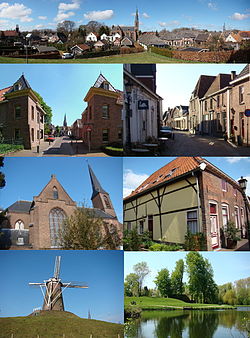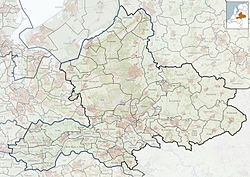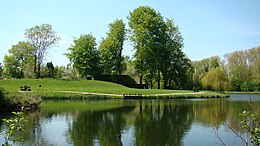
Arnhem is a city and municipality situated in the eastern part of the Netherlands, near the German border. It is the capital of the province of Gelderland, located on both banks of the rivers Nederrijn and Sint-Jansbeek, which was the source of the city's development.

Gelderland, also known as Guelders in English, is a province of the Netherlands, occupying the centre-east of the country. With a total area of 5,136 km2 (1,983 sq mi) of which 176 km2 (68 sq mi) is water, it is the largest province of the Netherlands by land area, and second by total area. Gelderland shares borders with six other provinces and the German state of North Rhine-Westphalia.

Zutphen is a city and municipality located in the province of Gelderland, Netherlands. It lies some 30 km northeast of Arnhem, on the eastern bank of the river IJssel at the point where it is joined by the Berkel. First mentioned in the 11th century, the place-name appears to mean "south fen". In 2005, the municipality of Zutphen was merged with the municipality of Warnsveld, retaining its name. In 2021, the municipality had a population of 48,111.

Aalten is a municipality and a town in the eastern Netherlands. The former municipalities of Bredevoort (1818) and Dinxperlo (2005) have been merged with Aalten.

Borculo is a city in the eastern Netherlands, in the municipality of Berkelland, Gelderland. Borculo was an independent municipality until 2005, when it merged with Eibergen, Neede, and Ruurlo. Other population centers in the municipality of Borculo were nearby Geesteren, Gelselaar, and Haarlo.

Buren is a town and municipality in the Betuwe region of the Netherlands. Buren has 27,168 inhabitants as of 1 January 2022.

Dinxperlo is a town and former municipality in the eastern Netherlands, situated directly at the Germany-Netherlands border.
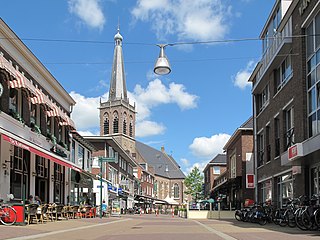
Doetinchem is a city and municipality in the east of the Netherlands. It is situated along the Oude IJssel river in a part of the province of Gelderland called the Achterhoek. The municipality had a population of 58,270 in 2021 and consists of an area of 79.66 km2 (30.76 sq mi) of which 0.61 km2 (0.24 sq mi) is water. This makes Doetinchem the largest town in the Achterhoek.

Lochem is a city and municipality in the province of Gelderland in the Eastern Netherlands. In 2005, it merged with the municipality of Gorssel, retaining the name of Lochem. As of 2019, it had a population of 33,590.

Ruurlo is a village and former municipality in the province of Gelderland in the eastern part of the Netherlands.

Winterswijk is a municipality and a town in the eastern Netherlands. It has a population of 29,022 and is situated in the Achterhoek, which lies in the easternmost part of the province of Gelderland in the Netherlands.

Arnold Joost van Keppel, 1st Earl of Albemarle,, and lord of De Voorst in Guelders (Gelderland), was a Dutch military leader who fought for King William III of England and became the first Earl of Albemarle. He had a very close relationship with William and proved a capable cavalry commander. In the latter stages of the War of the Spanish Succession he sometimes assumed Dutch supreme command in absence of the Count of Tilly.
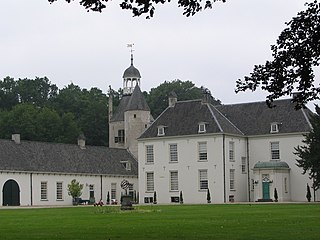
Terborg is a small city in the Dutch province of Gelderland, in the Achterhoek region in the east of the Netherlands. It is located in the municipality of Oude IJsselstreek. The city lies about 7 km southeast of Doetinchem. The population is about 4600 inhabitants.

Varsseveld is a town in the Netherlands, located in the Dutch municipality of Oude IJsselstreek.

The Achterhoek is a cultural region in the Eastern Netherlands. Its name is geographically appropriate because the area lies in the easternmost part of the province of Gelderland and therefore in the east of the Netherlands, protruding into Germany. The Achterhoek lies at the east of the IJssel and Oude IJssel rivers. On the other sides, it borders Germany to the southeast and the province of Overijssel to the northeast.
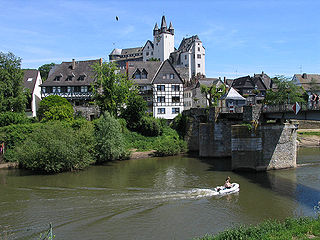
Diez an der Lahn is a town in Germany's Rhein-Lahn district in Rhineland-Palatinate, on the borders of Hesse. Diez is the administrative seat of the municipality of Diez.

Willem IV, Count van den Bergh (1537-1586) was the Dutch Stadtholder of Guelders and Zutphen from 1581 until his arrest for treason in 1583.

De Heurne is a village in the municipality of Aalten, near Dinxperlo, Province of Gelderland, in the east of the Netherlands.
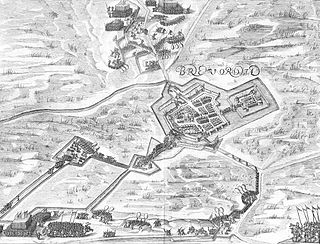
The siege of Bredevoort in 1597 was a siege of Bredevoort by the military forces led by Maurice of Nassau, Prince of Orange, during the Eighty Years War and the Anglo-Spanish War. The siege lasted from 1 October until 9 October; after that day Bredevoort was occupied by the besiegers. The siege was part of a campaign during which Maurice conquered the cities Turnhout, Alphen, Rijnberk, Meurs, Bredevoort, Groenlo, Goor, Enschede, Oldenzaal, Ootmarsum, and Lingen.

Suderwick is a village in the city of Bocholt, Kreis Borken in the German State of North Rhine-Westphalia. Suderwick is situated at the Germany-Netherlands border and forms one urban area with Dinxperlo, a town in Aalten municipality of Gelderland province of the Netherlands.
